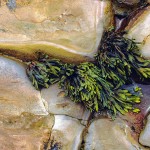
A news video from News Channel 5 about algae as a feedstock for biofuel production.
Bioengineers, Yaso Yoshikuni and his colleagues, at the Berkeley Laboratory devised a way to transform seaweed into biofuel. Their groundbreaking findings were published this year in Science. Specifically, Yaso Yoshikuni and his colleagues discovered that an E. coli biopathway leads to the breakdown of an algae component (alginate) into simple sugars then finally to fuel. The seaweed in question is Phaeophyceae, brown algae, most commonly found on the Californian coast. Seaweed, compared to other types of feedstocks like corn, maize or sugar cane, are more economically beneficial and sustainable. Brown algae as a feedstock for biofuel could potentially make a more sustainable economy in the future.
Why brown algae?
Brown algae is found to be a more sustainable source of biofuel than corn or sugarcane because it is already found in large quantities in sea water and produced for food supplies. The brown algae intended for biofuel feedstock will be found on existing seaweed farms and thus will not require more space for its production. In addition, brown algae are one of the fastest growing seaweed. For instance, one type of brown algae, the kelps, are known to grow at least 1 metre per day! In addition to naturally fast growing brown algae,the worldwide seaweed industry is estimated to be 5.6 billion U.S. dollars according to the Food and Agriculture Organization of the United Nations. The big and existing market of seaweed and its naturally fast growth make the brown algae an economically feasible option as a feedstock for biofuel.
Other possible sources of biofuel
There are other ways for converting biomass into fuel. Sugar canes, corn and maizes are some of the sources already engineered to produce ethanol (a component of fuel). These examples have some economic disadvantages. Using them as a feedstock would take away valuable food supply and require energy intensive processes. Green algae has also been considered as a source of biofuel but they are not as fast growing as brown algae and do not contain significant amount of alginate for the production of ethanol.
Challenges of biofuel production
While brown algae is more economically feasible than other types of biomass, there are still some obstacles to overcome before biofuel production is made possible. First, in order for biofuel production from brown algae to be competitive to fuel production, it requires billion of tonnes of large-scale production. Simply, the production of biofuel from brown algae cannot keep up with the fuel production just yet. In addition, transport of biomass from its natural source and to processing manufacturers is another challenge. The technicality of biofuel production is not well established for biofuel production to compete with the fuel production.
References
http://www.nature.com/news/biofuel-from-beneath-the-waves-1.9860
http://www.newscientist.com/article/dn12283-corn-biofuel-dangerously-oversold-as-green-energy.html
http://aem.asm.org/content/77/16/5822
More videos about biofuel production: https://www.youtube.com/watch?v=92unk4k-N3k&feature=related



